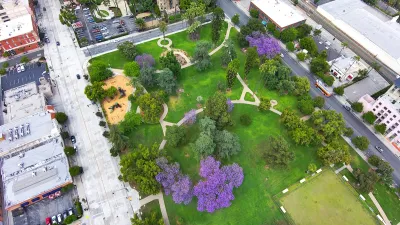July is Park and Recreation Month and this year’s theme is “We Rise Up for Parks and Recreation.” One way for park and recreation professionals to rise up is for them tell their stories.

Parks are sometimes dismissed as “nice-to-haves” or as being just about “fun and games.” But parks are essential infrastructure that provide a wide range of benefits to communities. Specifically, parks offer a variety of environmental, social, and economic benefits both within and beyond park boundaries, as summarized below:
Environmental
- Improve air quality
- Capture and clean stormwater
- Mitigate heat and stabilize temperature
Social
- Improve public health
- Improve community safety
- Enhance community cohesion
- Improve walkability
- Reduce stress and improve academic performance
Economic
- Increase property values
- Create temporary and permanent jobs
In this article, park planner Clement Lau encourages fellow park and recreation professionals to tell their personal and professional stories to:
- Make the case for parks and recreation
- Counter false narratives
- Encourage and inspire each other
- Reflect and learn
While Lau's preferred method of sharing his stories is through articles and blog posts, he notes that narratives in support of parks and recreation may also be told via posts on social media outlets like Facebook, Instagram, LinkedIn and Twitter, media interviews, press releases, and official publications like annual reports, fact sheets, and other materials that can be shared with the public and decision-makers.
FULL STORY: We Rise Up by Telling Our Stories

Alabama: Trump Terminates Settlements for Black Communities Harmed By Raw Sewage
Trump deemed the landmark civil rights agreement “illegal DEI and environmental justice policy.”

Planetizen Federal Action Tracker
A weekly monitor of how Trump’s orders and actions are impacting planners and planning in America.

The 120 Year Old Tiny Home Villages That Sheltered San Francisco’s Earthquake Refugees
More than a century ago, San Francisco mobilized to house thousands of residents displaced by the 1906 earthquake. Could their strategy offer a model for the present?

In Both Crashes and Crime, Public Transportation is Far Safer than Driving
Contrary to popular assumptions, public transportation has far lower crash and crime rates than automobile travel. For safer communities, improve and encourage transit travel.

Report: Zoning Reforms Should Complement Nashville’s Ambitious Transit Plan
Without reform, restrictive zoning codes will limit the impact of the city’s planned transit expansion and could exclude some of the residents who depend on transit the most.

Judge Orders Release of Frozen IRA, IIJA Funding
The decision is a victory for environmental groups who charged that freezing funds for critical infrastructure and disaster response programs caused “real and irreparable harm” to communities.
Urban Design for Planners 1: Software Tools
This six-course series explores essential urban design concepts using open source software and equips planners with the tools they need to participate fully in the urban design process.
Planning for Universal Design
Learn the tools for implementing Universal Design in planning regulations.
Clanton & Associates, Inc.
Jessamine County Fiscal Court
Institute for Housing and Urban Development Studies (IHS)
City of Grandview
Harvard GSD Executive Education
Toledo-Lucas County Plan Commissions
Salt Lake City
NYU Wagner Graduate School of Public Service





























